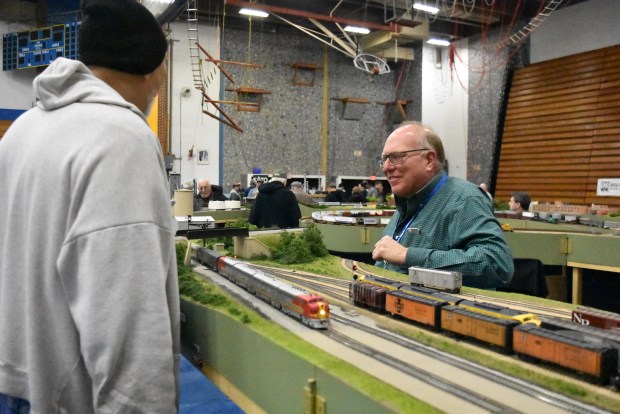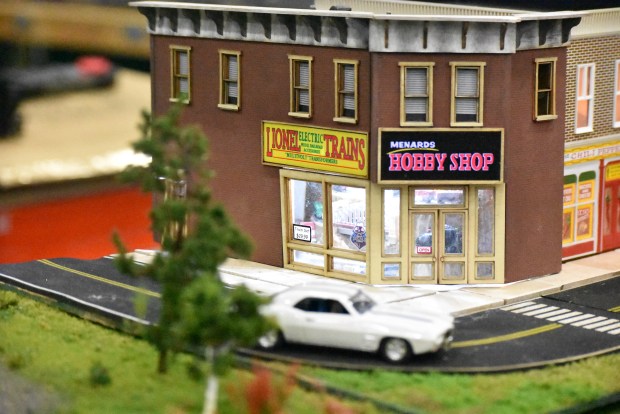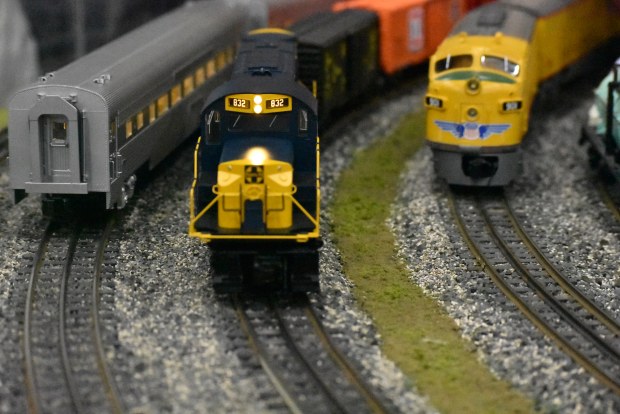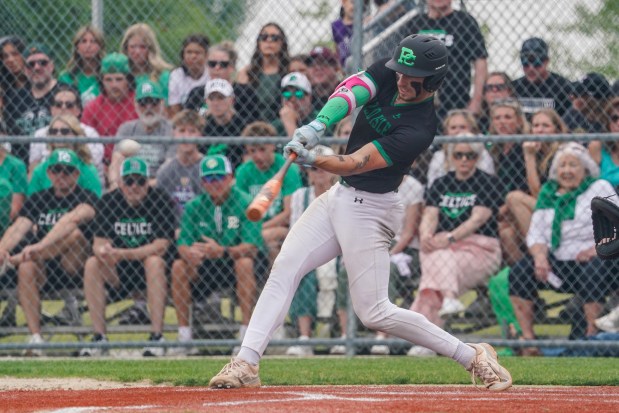For one day on Saturday, hundreds of visitors in La Grange got a chance to take a peek into the past at the annual All American Railroad Show, a sprawling display of bustling downtowns, classic cars and a look at what once connected most American towns and cities — the railroad.
The rolling stock included both freight and passenger, steam, diesel, and even a few electric trains, each with an era-accurate design and logo, a sort of alternate reality set in 1:87 scale. Size aside, the model trains differed from their real-life forebearers mostly in their destination.
All the live-long day in the Lyons Township High School North Campus gym, the trains went on and on down the track, circling through towns, mountains and freight yards. The sun never set and the little engines never yielded to a highway, a pipeline, or an airplane and their tracks never faced a future as a bike path or a hiking trail.
These trains aren’t going anywhere and they’ll be back again next year, on time and ready to go and when they come back, they’ll attract hundreds of more kids, eager to imagine and hundreds of adults, eager to remember.
For the event organizers and the enthusiasts who displayed the models, the work is the product of decades of love and a fascination that began decades ago. Patrick Golden, the coordinator of the All-American Railroad Show and a member of the DuPage Division of the National Model Railroad Association, said he got his first taste in 1961 when his dad brought home a Lionel model train set.
“He always said it was for us kids, but I realized later it was otherwise,” Golden said. “Well, he bought the Lionel set but then from the Lionel, I branched off in the HO gauge trains and model trains, once it’s in your blood it’s in your blood.”
Like any other hobby, it can cost as much in time and coin as a collector is willing to invest and the set-ups on Saturday reflected some serious investments on both fronts but that’s not the point of the show. Some meets offer swaps or opportunities to buy parts or cars, but the All American Railroad Show, though it is a fundraiser for the DuPage railroad club, doesn’t allow any selling or trading. The event raises its money from ticket and snack sales while the trains are for display only, a main attraction for the curious, the kids as well as the collectors.
“It’s just because our goal is families here,” said Golden. “You see a jillion little kids here watching the trains run.”

One of those eager spectators was Henry Norvilas, 4, who’s been an annual attendee for the last three years.
Maybe one day he’ll buy a set—or get one some Christmas—but Golden said kids and their parents shouldn’t have to feel any pressure to invest in anything on the spot.
“We don’t want that 4-year-old to fall in love with a high-priced item, and we raise enough money to keep our chapter running well,” he said. Indeed, Golden said this was the chapter’s biggest annual fundraiser and it allows the organization to donate money to various community projects, like a local Boy Scout chapter that needed a new trailer for camping outings.
But for every 4-year-old, there were serious collectors, too, often found on the other side of the tracks, talking up their models laid out proudly for a day on display.
Bob Kosic, a member of the Mod-U-Trak group, said he and four others set up their rig the night prior, after hauling it in on a 16-foot Penske truck. The Mod-U-Trak group is a Chicagoland-based club that specializes in standardized displays set within a specific geography, meaning tracks can be easily interchanged with each other. This also allows for a display to be easily disassembled, transported and set up so the group goes to a lot of train shows. Kosic said it only takes about five people to put the whole thing together.

Kosic’s track also featured recreations of various suburban communities set sometime in the 1950s, including Lombard, Romeoville, and Willow Springs.
Kosic, like Golden, got into train modeling from his father, who brought home a model kit when he, Kosic, was a small child. They both got hooked.
“We fell into the rabbit hole,” he laughed.
It’s a common story at the show among model enthusiasts, but there are still a few who found their way first into a love affair with the real deal.
Ralph Eisenbrandt began working as a teenager for the Rock Island, so young he couldn’t work the yards by law, so he started as a mail clerk and then a file clerk until he was 18, when he was old enough to work the yards.
“I got interested in railroads in high school,” he said. “It was natural; all the other kids in my school got into railroads.”
Eventually, he moved into another career and quit the Rock Island and while these days he doesn’t take any more Amtrak trips due to health issues, he never lost interest in the trains. As the crowds piled into the LTHS gym, he’s still fascinated by the machines and the models, though he does lament an industry that won’t afford curious boys much of a chance to work the yards.

“Unfortunately there’s not that many jobs out there like there used to be,” he said, before adding he’s still hopeful of a turnaround. Every year there’s talk and maybe even a little action.
“Around the country, there’s a resurgence in commuter lines,” he said. “And virtually every other counter in the world has a high-speed rail line.”
But in the meantime, there’s the All-American Railroad Show. It’s still going strong and it’ll be back again next year, right on time, in La Grange.
Jesse Wright is a freelance reporter for Pioneer Press.





